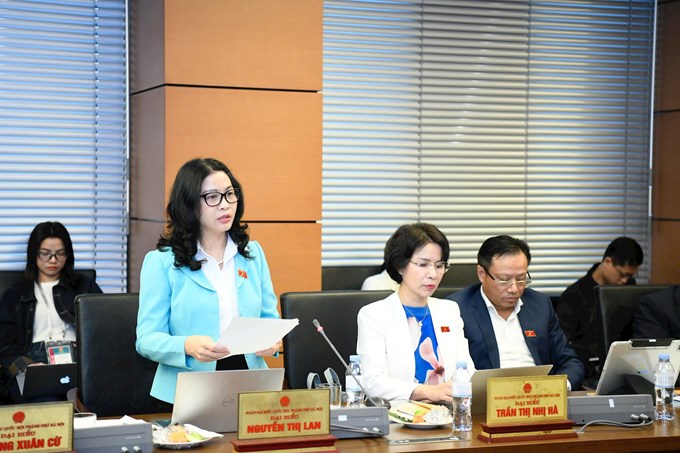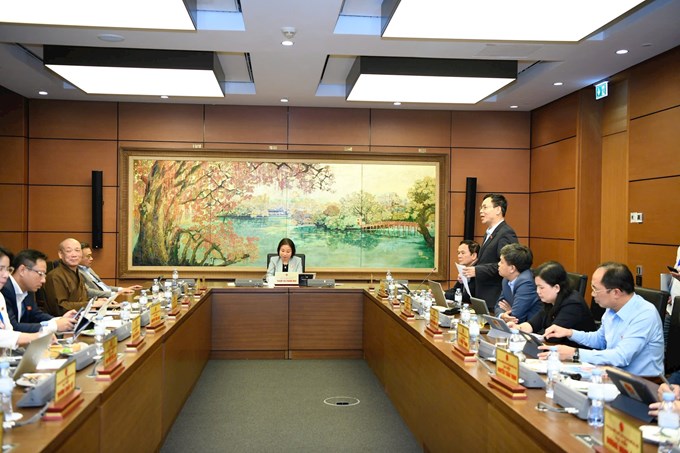Contributing her opinions on the Draft Law on Cybersecurity (Amended) at Discussion Group No. 1, National Assembly Deputy Nguyen Thi Lan (Hanoi delegation) emphasized that the draft law marked an important step forward, reflecting a modern legislative mindset that harmoniously combined protection with development. In particular, this amended draft demonstrated greater flexibility and practicality, keeping pace with global trends and contributing to building Vietnam into a digitally resilient, secure, and innovative nation.
Reflecting a Modern Mindset in Cybersecurity Governance
Deputy Nguyen Thi Lan highly appreciated the drafting committee’s thorough and responsible work, carried out with an open and constructive attitude. According to her, the Draft Law on Cybersecurity represented significant progress in improving the legal framework for safeguarding national sovereignty, information security, public order, and social safety in cyberspace.
“What I particularly value,” Deputy Nguyen Thi Lan emphasized, “is that the draft law has been developed with vision and depth, striking a harmonious balance between prevention, protection, management, and enforcement, clearly reflecting a modern approach to cybersecurity governance.”

National Assembly Deputy Nguyen Thi Lan speaks during the discussion session of Group 1.
According to Deputy Nguyen Thi Lan, in the context of comprehensive digital transformation, cybersecurity was not only a “protective shield” but also a “soft infrastructure” that promoted innovation, research, and the application of technology, particularly in science and agriculture, the two key pillars of the knowledge economy and national food security.
Based on her study, Deputy Nguyen Thi Lan noted that the current draft law introduced several noteworthy improvements. First, the legislative approach was highly progressive, it not only focused on protection but also aimed at sustainable development in the digital era. Second, the draft law classified information systems by level, clearly identifying the list of critical systems, thereby helping to safeguard the nation’s digital infrastructure. Third, it emphasized the development of science and technology, human resources, and international cooperation, demonstrating a long-term vision aligned with global integration trends. Fourth, it clarified the responsibilities among agencies, organizations, and enterprises, thereby establishing a coordinated and transparent mechanism. “Overall, this is a solid legal framework that not only ensures cybersecurity but also promotes innovation, digital transformation, and sustainable development,” Deputy Nguyen Thi Lan analyzed.
Contributing her opinions to clarify several provisions in the draft law, specifically Article 40 on Cybersecurity Research and Development, Deputy Nguyen Thi Lan observed that the draft already mentioned the research and development of cybersecurity software and equipment. However, it had not had yet specify mechanisms for research collaboration, data sharing, and the development of high-quality human resources. The Deputy, therefore, proposed adding provisions to encourage cooperation among research institutes, universities, and enterprises, both domestic and international, in sharing data, developing technologies, and ensuring information security in scientific and innovation activities.
“There is currently no law that specifically regulates this issue, so this is a new and highly necessary proposal. If incorporated, this provision would connect the State, scientists, and businesses, thereby forming a national cybersecurity innovation ecosystem. Experience from South Korea and Singapore shows that such collaborative models have enabled them to ensure cybersecurity while simultaneously advancing their digital technology industries,” Deputy Nguyen Thi Lan stated.
Protecting Agricultural Data Infrastructure and Ensuring Food Security
Regarding Article 14 on Critical information systems related to national security, the current list already covered many sectors such as energy, finance, healthcare, transportation, and the environment. However, Deputy Nguyen Thi Lan noted that the draft law had not had mentioned agriculture and food security yet, even though this was a sector undergoing rapid digital transformation. And it was observed that today’s agriculture increasingly applied IoT, satellite technology, artificial intelligence (AI), and blockchain, meaning that data on crops, varieties, and supply chains were highly vulnerable to cyberattacks, which could threaten both food security and social stability.
Therefore, Deputy Nguyen Thi Lan proposed adding the following content to Clause 2: “National information systems in the fields of agriculture, food security, agricultural supply chains, and natural resource data.” This provision would help protect agricultural data infrastructure and ensure food security, while also encouraging businesses and universities to invest more in technology and cybersecurity. Experiences from countries such as Israel and Japan showed that they regarded agricultural data as a strategic resource, which were protected at the same level as energy or finance.

Overview of the discussion session of Group 1
Regarding Article 34 on Cybersecurity standards and technical regulations, National Assembly Deputy Nguyen Thi Lan noted that this article authorized the Ministry of Science and Technology to issue technical standards. However, it currently lacked a mechanism for technological sandbox testing in fields such as cybersecurity, data science, artificial intelligence (AI), and smart agriculture. In reality, technology often evolved faster than legal frameworks; without a flexible testing mechanism, it would be difficult to encourage innovation. Therefore, the Deputy proposed adding the following provision “The State shall allow controlled pilot testing (sandbox) for new technologies in the fields of cybersecurity, data science, artificial intelligence, and smart agriculture before the official issuance of technical standards.”
“The sandbox mechanism,” Deputy Nguyen Thi Lan explained, “will enable enterprises and research institutes to experiment with innovations in a safe environment while providing regulatory agencies with real-world data to formulate appropriate standards. This model has been effectively implemented in the European Union, Japan, and Australia, ensuring public safety while fostering innovation and enhancing national competitiveness.”